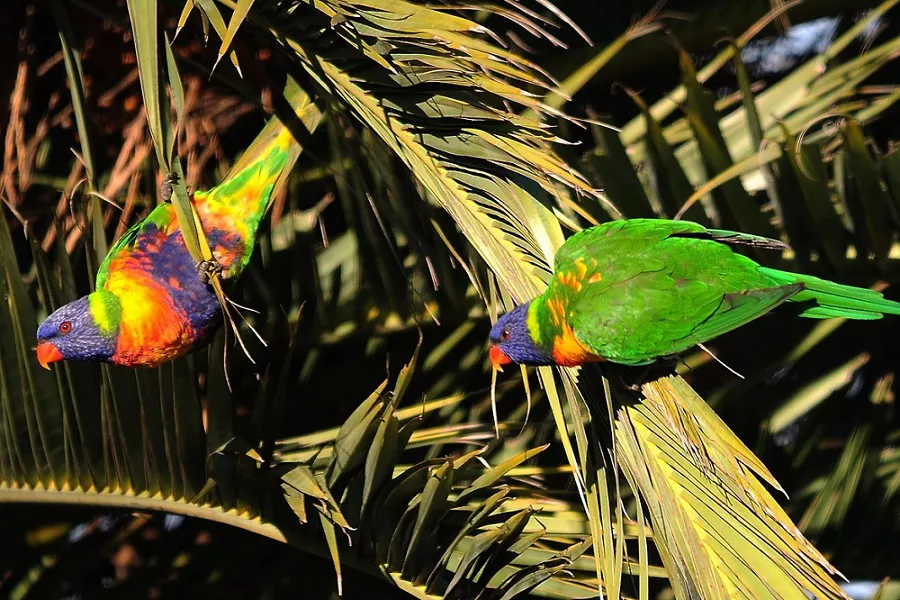Lorikeets are a group of small to medium-sized parrots that are known for their striking colors and energetic personalities. Among the most popular lorikeet species kept as pets are the Coconut Lorikeet and the Rainbow Lorikeet. Despite their similarities, these two species have distinct differences in terms of appearance, behavior, and habitat. In this article, we will explore the differences between Coconut Lorikeet and Rainbow Lorikeet.
Appearance
The first difference one would notice between these two species is their physical appearance. While both birds belong to the same family (Psittacidae) and share some similarities in coloration, they have several distinguishing features.
The Coconut Lorikeet is a small bird that measures about 20 centimeters (8 inches) in length, with predominantly green plumage, dark blue-black wings, a bright red beak, and a blue forehead. One unique feature of this bird is its chestnut-colored collar, which sets it apart from other lorikeet species. Additionally, the Coconut Lorikeet has a shorter tail compared to the Rainbow Lorikeet.
On the other hand, the Rainbow Lorikeet is larger, measuring about 30 centimeters (12 inches) in length. It has a predominantly green body, with a blue head and belly, yellow breast, orange-red beak, and red-orange thighs. The Rainbow Lorikeet’s wings are also longer and more pointed, making it a faster and more agile flyer than the Coconut Lorikeet.
Behavior
Another significant difference between the Coconut Lorikeet and Rainbow Lorikeet is their behavior. Both species are highly social and active birds, but they have different temperaments and tendencies.
Coconut Lorikeets are generally quieter and calmer than Rainbow Lorikeets. They are less likely to screech or squawk loudly, making them a better option for those who prefer a quieter pet. Coconut Lorikeets are also known for their curious and playful nature, and they enjoy interacting with their owners.
Rainbow Lorikeets, on the other hand, are more vocal and active. They have a tendency to screech and make loud noises, which can be disruptive in some living situations. These birds require plenty of mental stimulation and physical exercise to prevent boredom and destructive behavior. Rainbow Lorikeets are also known to be more aggressive towards other birds, including their own kind.
Habitat
Coconut Lorikeets and Rainbow Lorikeets have different natural habitats. The Coconut Lorikeet is native to the islands of the South Pacific, including Samoa, Fiji, and Tonga. These birds inhabit forests, plantations, and gardens and are commonly found at altitudes below 600 meters (2000 feet) above sea level.
Rainbow Lorikeets, on the other hand, are native to Australia’s east coast, from Queensland down to South Australia. These birds inhabit rainforests, woodlands, and urban areas, including parks and gardens. Rainbow Lorikeets are highly adaptable and can thrive in various habitats, provided they have access to food and water sources.
Diet
Both Coconut Lorikeets and Rainbow Lorikeets are nectarivorous, meaning they primarily feed on nectar from flowers. However, they have different dietary requirements and preferences.
Coconut Lorikeets have a broader dietary range than Rainbow Lorikeets and may also consume fruits, seeds, and insects. They are particularly fond of coconut flesh, hence their name. In captivity, Coconut Lorikeets require a balanced diet that includes nectar supplements, fresh fruits, and vegetables.
Rainbow Lorikeets have a more specialized diet and rely heavily on nectar as their primary food source. In addition to nectar, they may also feed on pollen, fruit, and insects. In captivity, Rainbow Lorikeets require a specialized diet that mimics their natural diet, consisting of nectar supplements, fruits, vegetables, and protein sources such as boiled eggs or cooked chicken.
Conclusion
In summary, Coconut Lorikeet and Rainbow Lorikeet are two distinct species of lorikeet with significant differences in appearance, behavior, habitat, and diet. While both birds make excellent pets for those who enjoy the company of colorful and active birds, it is important to consider these differences when choosing a pet and providing for its needs. With proper care and attention, either species can be a rewarding and delightful companion for many years to come.


 Facebook
Facebook  Instagram
Instagram  Youtube
Youtube 